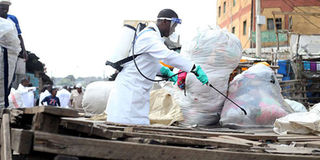Premium
More people died with schools closed, study by UK varsity says

Nairobi health official disinfects stalls at Gikomba market on march 21, 2020 to prevent the spread of Covid-19.
What you need to know:
- The researchers at Edinburgh University predicted that, over the entire course of the pandemic, keeping children out of classrooms would increase deaths by between 80,000 and 95,000.
- Social distancing for everyone, rather than just the over-70s, could cost between 149,000 and 178,000 lives.
The closure of schools may have cost more lives than if herd immunity had been allowed to build slowly in the community, a study suggests.
One criticism of the closures is that reduced contact at school leads to increased contact at home, meaning that children infect high-risk adults rather than low-risk minors.
According to the study published in the BMJ journals on Thursday, scientists reasoned that the virus was able to spread faster to vulnerable people once lockdown measures including school closures were introduced than if some level of immunity had been allowed to build up in the young.
“Had the schools been left open, there are high chances that young people would have developed immunity and not been able to transmit the virus,” the study states.
It also indicated that the survival rate for infected young people was high compared to that of the elderly.
Social distancing
The researchers at Edinburgh University predicted that, over the entire course of the pandemic, keeping children out of classrooms would increase deaths by between 80,000 and 95,000.
Likewise, social distancing for everyone, rather than just the over-70s, could cost between 149,000 and 178,000 lives. The study suggested that stronger interventions are associated with suppression of the infection such that a second wave is observed once the interventions are lifted.
For example, adding place closures to case isolation, household quarantine, and social distancing of over 70s substantially suppresses the infection during the intervention period compared with the same scenario without place closures.
However, this suppression then leads to a second wave with a higher peak demand for ICU beds than during the intervention period, and total numbers of deaths that exceed those of the same scenario without place closures.
“We therefore conclude that the somewhat counterintuitive results that school closures lead to more deaths are a consequence of the addition of some interventions that suppress the first wave and failure to prioritise protection of the most vulnerable people,” said Ken Rice, professor of computational astrophysics at Edinburgh University.
More deaths
He added that, when the interventions are lifted, there is still a large population who are susceptible and a substantial number of people who are infected. This, then leads to a second wave of infections that can result in more deaths, but later.
“Further lockdowns would lead to a repeating series of waves of infection unless herd immunity is achieved by vaccination, which is not considered in the model,” he said. The revelation comes at a time when thousands of scientists across the world signed the Great Barrington Declaration, calling for an end to lockdown for young and healthy people.
“Coming from both the left and right, and around the world, we have devoted our careers to protecting people. Current lockdown policies are producing devastating effects on short and long-term public health. The results include lower childhood vaccination rates, worsening cardiovascular disease outcomes, fewer cancer screenings and deteriorating mental health leading to greater excess mortality in years to come, with the working class and younger members of society carrying the heaviest burden. Keeping students out of school is a grave injustice,” said the scientists.
“Fortunately, our understanding of the virus is growing. We know that vulnerability to death from COVID-19 is more than a thousand-fold higher in the old and infirm than the young. Indeed, for children, COVID-19 is less dangerous than many other harms, including influenza,” they added.





